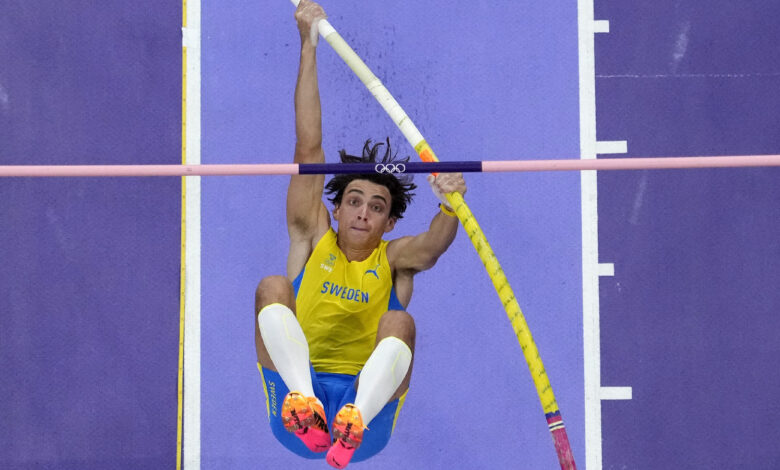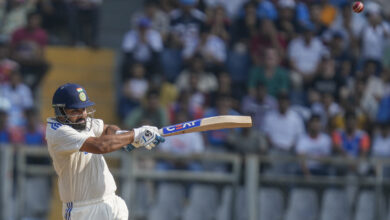Paris Olympics: Meet Armand Duplantis – who is taking pole vault to unprecedented heights | Sport-others News

At the top of his run-up, waiting for take-off, Armand Duplantis inhaled a burst of breath, blew out the air, ran his hands over a malleable stick that weighs five pounds, and stared into the beatific Parisian skies. Nearly 15 seconds later, he blended into the skies so much so that he could see the stars closer than any human without space jackets and parachutes could, and sniff the heavens closer than any of his race could.
It was the ninth time he had rewritten the world record. But the most startling feature of the moment was how ridiculously simple a manoeuvre he made it look, without a violent eruption of energy, without a wicked stretching of his sinews, without even breaking into a storm of sweat.
Just like that, as though he were plucking a fruit from his back garden, as though it were merely an instinct. Perhaps it really is, a memory his muscle had ingrained since he was three, the first time he tried pole-vaulting, under the shocked gaze of his father Greg, an elite pole vaulter in the 1990s, and mother Helena, a heptathlete.
The 24-year-old Swede, though, was oversimplifying the most complex synthesis of human movements in athletics, a burning obsession of biomechanics scients. He reels down the runway like a sprinter, straight-backed and still-headed, his shock of blonde hair bouncing and flapping in the wind of energy he generates, and completes 20 strides in a fraction over 10 seconds. He has an immediate advantage of speed over his rivals—it’s not a surprise that he set a school record in Louisiana when he ran the 100m in 10.57s. “He’s just so fast down the runway. He’s faster than all of us quite a bit. Speed equals height in pole vault,” KC Lightfoot, one of his American competitors, would enviously observe about his toughest adversary. Duplantis has long-jumped 7.15m at school, and could have set records had he tried his luck on the gymnastics floor or the high jump pit too.
Smooth operator
Then comes the subtle art of transferring his weight onto the vault. He uses a slightly heavier pole that generates more recoil force, and grips the pole much higher than the average vaulter to get more leverage, a technique made famous the godfather of pole vault, Sergei Bubka.
The Swede holds the pole on a vertical plane with soft hands, letting the force of gravity pull it down, in his run-up. He then raises his arms to slide (rather than plant) the pole tip in the metal vault box, bends it to the limits, before it begins to wince in pain.
When he is almost under the bar, he flips his body backwards, upside down for maximising the recoil effect, clinging like a sloth on the branch of a tree, lets the grip off the pole, setting off vigorous vibrations of the fibreglass staff, catapults his body skywards and curls it over the bar. If one pauses the footage at the exact moment when he crossed 6.25m, when he is suspended weightlessly in the air like a spaceship, one would notice the enormous space between his body and the bar, which is the scale of his athleticism, the all-encompassing mastery of his art.
A whle escapes his lips as he plunges to the mat, the landing as smooth as the take-off, before, certain of the record he has set, rips off his shirt like a goalscorer in a big game would. At that moment, he could have reproduced the immortal lines of Bubka: “I want to be an art of the pole vault. I want to create something new and unusual, I want to break barriers. I pole-vault from the bottom of the heart.” Like Bubka, Duplantis has redesigned the complex sport into a melody, into a dance form. He jumps from the bottom of the heart too.
In a league of his own
Duplantis has already created something new, broken several barriers to the extent that he himself is his biggest barrier, toughest competitor and hardest challenger. Fathom this: nine of the top 10 jumps in hory are in his name, the sequence breaker being Renaud Lavillenie, now part of his coaching staff. The first time he broke the world record was in February 2020, he would shatter that eight times in the next four years, that is at least twice a year. He owns one third of the jumps — 61 out of 189 — over six metres ever. Eight of them have arrived this year alone. He became only the second pole-vaulter to defend his Olympic gold, a feat that eluded even Bubka, besides defending world outdoor and indoor titles.
Such superiority is rare in any sport — Usain Bolt in his pomp, Bubka last century, or Rafael Nadal at Roland Garros. Duplantis —monikered Mondo which means “world” in Italian, given an Italian family friend — himself is at a loss to explain his superiority, monopoly rather: “What can I say? I just broke a world record at the Olympics, the biggest possible stage for a pole vaulter. [My] biggest dream since I was a kid was to break the world record at the Olympics, and I’ve been able to do that in front of the most ridiculous crowd I’ve ever competed in front of.”
To think that he is just 24, yet to hit his peak years, and has many vaults left in the tank, baffles the mind about the summits he could still conquer, about the ceiling of human ambition and athleticism he could set. Each time he breaks a record, he becomes richer $100,000, but that’s just the garnishing to the extraordinary stretching of human limits a near-supernatural force, who leaves the stage not only with a fresh record but a feeling that the best is yet to be.







